Connector Basics: The Main Components of a Connector
Can you identify the basic parts that make up a connector? In this excerpt from the new book, “Electrical Connectors: Design, Manufacture, Test, and Selection,” two professors share fundamental knowledge about the principals of interconnect technology.
By Michael Pecht and San Kyeong
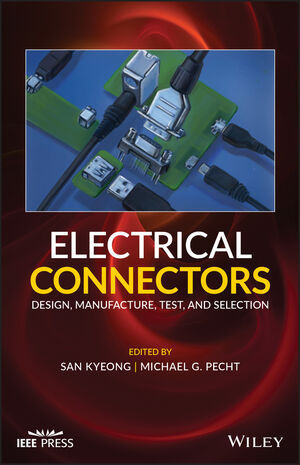 Separable connectors are a vast and diverse components group. Each connector type and category is defined by form factors, materials, capabilities, and special features that make them uniquely suitable for the applications into which they are designed. Connectors share basic features as well. The main components of a connector include the contact springs, contact finish, and connector housing. The contact interface is defined by the physical electrical connection of the pieces of the connector that are mated, and this determines how well the connector performs.
Separable connectors are a vast and diverse components group. Each connector type and category is defined by form factors, materials, capabilities, and special features that make them uniquely suitable for the applications into which they are designed. Connectors share basic features as well. The main components of a connector include the contact springs, contact finish, and connector housing. The contact interface is defined by the physical electrical connection of the pieces of the connector that are mated, and this determines how well the connector performs.
Contact Springs
The contact spring provides the path for the transmission of a signal, power, and/or ground between the circuits that a connector connects. It also provides the normal force, the component of the force that is perpendicular to the surface of contact, which helps in the formation and maintenance of the separable interface.
The key mechanical requirements of the contact spring are insertion and extraction force, contact force, contact retention, and contact wipe. The electrical requirements of the contact spring are contact resistance, current rating, inductance, capacitance, and bandwidth.
There are two types of contact springs: a receptacle, which is generally a spring member, and a plug, which in most cases is rigid and provides a means for deflecting the receptacle spring to generate the contact normal force. A receptacle contact spring ensures low insertion force while mating and helps the connector endure overstress during nonaligned insertions.
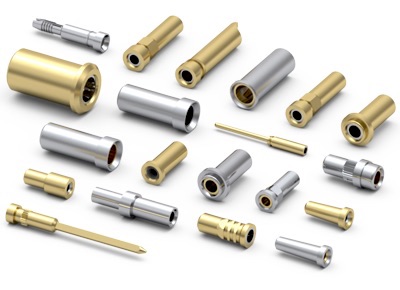
This selection of machined pin receptacles by Mill-Max is designed to function reliably for 1,000 insertion/extraction cycles or more, depending upon mating pin size, shape, and finish.
The material properties that influence the performance of the contact spring are the modulus of elasticity and the yield strength. The modulus of elasticity is the ratio of the stress applied to the object to the resulting strain within the elastic limit. The yield strength is the point of stress at which the body begins to deform plastically. Before the yield strength is reached, the body deforms elastically; that is, it returns to its original shape when the stress is removed. These properties influence the deflection abilities of the spring and the amount of deflection the spring can support while remaining elastic. This also affects the contact force required to make a proper electrical connection.
Stress relaxation resistance is a property of the material that reduces the contact normal force over time. Thus, it is a selection criterion that can affect connector performance. It is the decrease in stress that occurs when the structure is kept in the same strained posture for some interval of time, causing the formation of plastic strain. Loss of normal force through plastic deformation is a design exercise to ensure that spring stresses are not excessive. The yield strength is different for commonly used copper alloys; hence, stress relaxation resistance varies across them. Beryllium copper is the most commonly used alloy when stress relaxation resistance is a concern. Phosphor bronzes are also suitable for most applications.
Contact Finishes
The contact finish protects the contact spring base metal from corrosion and limits the formation of films on the surface of the contact spring. To be effective, the contact finish has to completely cover the contact spring and must be corrosion resistant.
Films that can increase the contact resistance include thin oxides, sulfides, chloride, and complex mixtures of film layers of the metals formed on the contact’s surface. The reduction of contact resistance requires the formation of a metallic interface that is free of films. Contact finishes can be made of noble metals (e.g., gold, palladium, and alloys of these metals) or non-noble metals (e.g., silver and tin). The type of finish determines the types of surface films that can form on the contact interfaces. The noble metals, and especially gold, are inert because there is no formation of any oxides on the surface. In the case of non-noble metal finishes made of tin, however, tin-oxide can form in the contact spring and may need to be periodically removed.

Lemco Précision SA manufactures pins and sockets in a wide selection of contact finishes, electroplating, nickel plating, and contact gold plating.
Owing to the repeated mating and unmating in separable contact interfaces, some of the surface film is removed by frictional forces. Therefore, two layers of contact finishes referred to as “duplex-plated” are used to protect the underlying metal. These consist of a layer of noble metal coated on top of a layer of nickel.
Noble Metal Contact Finishes
The noble metals — including gold and, to a lesser extent, palladium and its alloys — are inert in typical connector operating environments without the presence of acidic gases. But in environments where chlorine or sulfur is present, corrosion of noble-metal-finished connectors can occur. Shielding by housing can help prevent corrosion. Lubrication is another means of protection.
Pore corrosion and corrosion due to exposed base metal are of particular concern. If the coating with noble metal is not thick enough, or if it is not continuous, the underplate and base metal will be exposed to the environment, leading to corrosion. At elevated temperatures, base metal atoms may migrate to the contact surface and react with oxygen and pollutant gases, allowing corrosion products to migrate out of the pores. This phenomenon is called pore corrosion. Hence, pore corrosion of the copper layer beneath the noble metal layer can take place when the noble metal layer becomes porous, exposing the copper to a corrosive environment containing acidic gases of sulfides and chlorides.
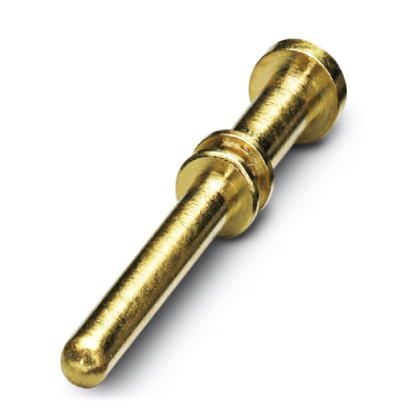
This copper-zinc Phoenix Contact pin features nickel plating over a gold coating.
Because gold is a noble metal and because thin gold platings tend to be porous, gold coatings are susceptible to the creep of base metal corrosion products across the surface of the gold after formation at pore sites and edge boundaries. Corrosion creep can be inhibited by applying an overall nickel coating prior to application of the gold.
Non-Noble Metal Contact Finishes
Non-noble metal contact finishes consist primarily of tin, although silver, nickel, solder, and lead are commonly used. Alloys of tin-lead and nickel-tin are also used sometimes. Tin finishes degrade primarily because of fretting corrosion, which can occur in any operating environment. Fretting corrosion is caused by repeated micromotions between closed contacts, creating oxides or wear debris that can raise contact resistance. Micromotion can result from vibration, shock, or differential thermal expansion of materials in contact. The connector must be designed to minimize fretting susceptibility, which can be done by providing sufficient friction force at the contact interface to prevent motion from occurring.
Tribology refers to the study of friction, lubrication, and wear of contact surfaces. Contact finishes are generally thin. It is therefore essential to maintain the integrity of the contact finishes when subjugated to wear and tear to protect the base metals from exposure to a corrosive environment. The resistance to corrosion and tarnishing and the thermal stability of contact resistance should be kept in mind when choosing a contact finish.
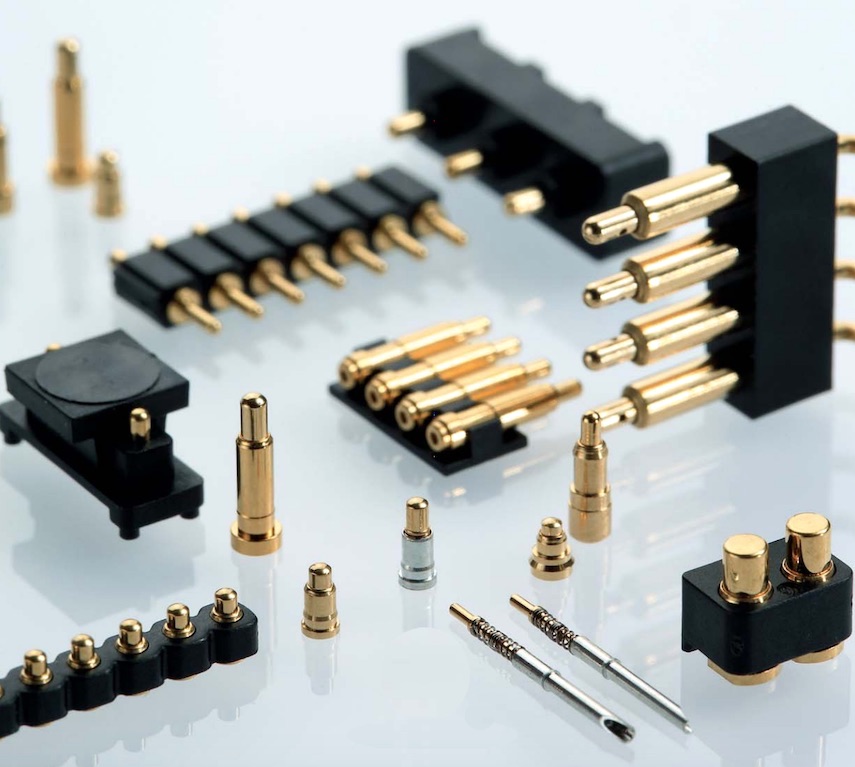
Preci-Dip’s spring-loaded contacts are engineered for high-reliability applications including medical, military, and aerospace electronics, and can be specified with a variety of platings depending on application requirements.
Connector Housing
Connectors must remain dimensionally stable in the presence of extreme chemical and temperature effects. The maintenance of connector center line spacing, straightness, and flatness is necessary for ensuring proper connector assembly and mating behavior. The connector housing achieves this stability by electrically insulating and mechanically shielding the contact spring, maintaining the position of contacts, and providing mechanical protection of the contacts from the operating environment.
The electrical properties that affect the insulating abilities of the housing include surface and volume resistivity and dielectric withstanding voltage. The mechanical characteristics of the connector housing include flexural strength/modulus and creep strength.
Most of the contact housing designs are similar, but the material used in them varies. This material range serves not only to meet the environmental conditions during operation but also to meet the conditions while manufacturing and assembling. Some of the common materials that are used for making connector housings are polyphenylene sulfide (PPS), polyethylene terephthalate (PET), polybutylene terephthalate (PBT), polycyclohexylenedimethylene terephthalate (PCT), liquid crystalline polymer (LCP), FR-4, and polyimide.
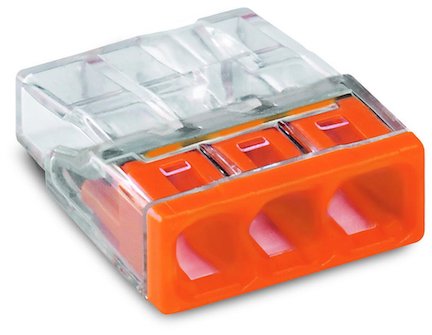
WAGO’s COMPACT PUSH WIRE connector features a unique transparent connector housing.
Contact Interface
A separable interface is established each time the male and female parts of a connector are brought into contact. There is a need to create and maintain contact interfaces to achieve the desired electrical performance. The metallic interface is created mechanically.
When separable connectors are mated, only the high spots on the surfaces, which are called asperities, come into contact. Therefore, the entire connector surface does not come into contact. The asperities depend on the geometry of the surfaces in contact. The size and the number of asperities depend on the surface roughness and the applied load. The applied load also determines the magnitude of the contact area.
Copyright John Wiley & Sons Limited, 2021, Electrical Connectors: Design, Manufacture, Test, and Selection, San Kyeong and Michael G. Pecht (Editors), 9781119679769.
This article is an excerpt from the new book, “Electrical Connectors: Design, Manufacture, Test, and Selection,” which covers everything one would need to design, manufacture, and select a connector for any targeted application. It includes the science of contact physics and the engineering involved in the choice and manufacture of contact materials, contact finishes, housing materials, and the full connector assembly process. Test methods, performance and reliability concerns, and guidelines are provided, and various application requirements and selection considerations are discussed.
Michael Pecht is the Director of CALCE (Center for Advanced Life Cycle Engineering) and a Chair Professor at the University of Maryland. He is an IEEE Fellow, an ASME Fellow, and an SAE Fellow. San Kyeong holds a post-doctoral position at CALCE the University of Maryland and is a staff engineer at Samsung Electro-Mechanics.





